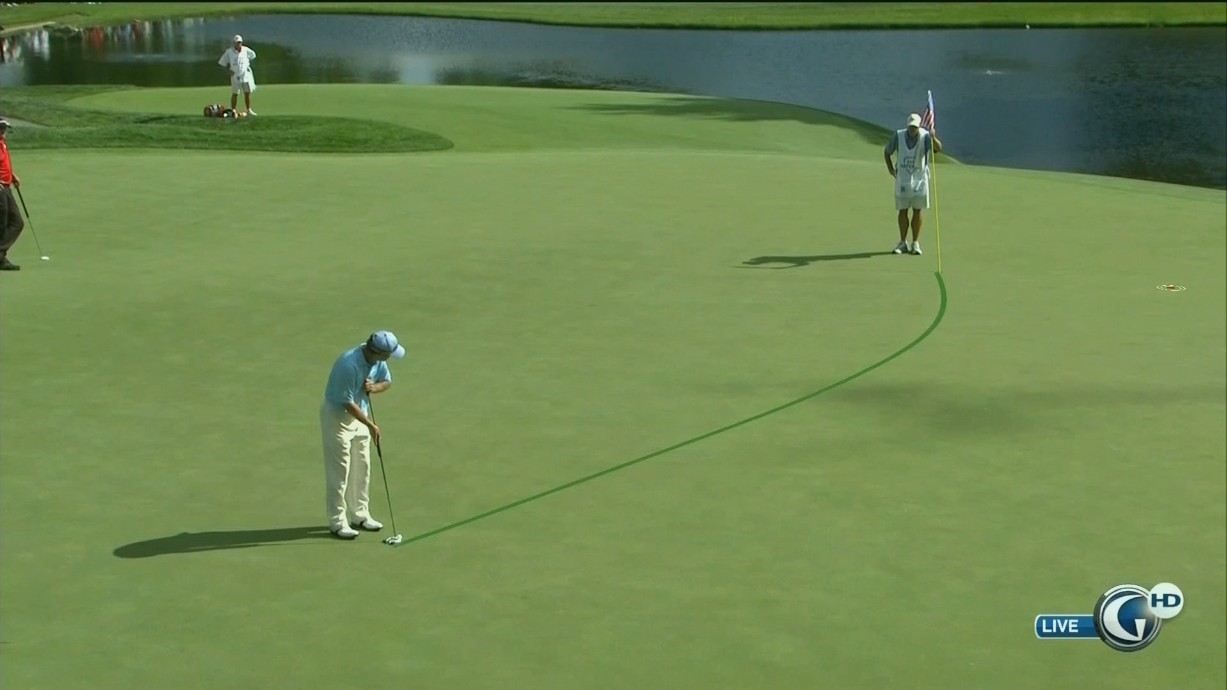
Part 6 of my Aimpoint Odyssey.
Well, I played last week. At my home course, I continued the improve my putting. However I still had tons of questions, tons of mysteries that needed to be demystified. It’s been 10 weeks since my original Aimpoint clinic. I’ve read everything I could get my hands on in the Aimpoint forum, watched every video there was on YouTube, I needed some hands on instruction. So I gave my instructor a call.
Quick plug to Peter Brown, certified Aimpoint instructor out of Roseville, CA, which is the Sacramento area.
So we got together. The next 90 minutes were, in one word… awesome. Peter explained all of the questions I had. Let’s see if I can explain some advanced concepts here.
The fundamental class covered planar green reads. Simple zero lines that extend straight into infinity, and how to aim off of that. But what if that zero line curved? There is a close correlation to the zero line, which is the line on which the putt will be aimed straight, and the fall line. The fall line, as you may know, is basically the line in which water would flow off of the green. On a planar green, it will flow in one direction. On an undulating green, the flow will curve. So, in theory, anywhere on that fall line, if you aim straight at the hole, the putt will go in (assuming 6-12 inch speed). Now, I’m not saying it’s a straight putt… I’m saying it’s a straight aim. If you can grasp that visual, it’s pretty mind-blowing. Here’s a pic:

So the flag is at the top of the green, and you see 4 lines coming out from the flag. Those are the 4 zero lines for that pin placement. You see the 2 bottom lines curving… that’s due to the undulations. Any putt anywhere on that line is aimed straight at the hole. It may double or triple break, but it goes right to the hole. On an uphill putt, if you are left of the line, you aim left of the hole. How much is where the figuring out comes in, and too complex to explain here. So I learned how to find those lines and how to figure out the aim.
Now I’ve been practicing this concept about 3 1 hr sessions: OH MY GOD!!!! 40-50 foot putts that I would normally try to read visually and have NO CLUE what to do, has been made simple with Aimpoint. And again, I’m not reading these putts with my eyes. I’m feeling the slopes, I’m feeling the fall lines with my feet, and trusting the feel. I think this was the main reason I had a hard time with the Temecula greens: I didn’t understand how to handle the more complicated greens, and this helps explain that. There are other advanced concepts I don’t understand. But I’ll worry about that later. For now, I think what I’ve learned so far will help me 75% of the time.
I can’t wait to play again.
Editorial Note:
Here’s the full video that the screenshot above is taken. It’s a overview of the software they use to digitally map greens that would then be used to make the Aimpoint lines on TV.
About GK Member michaelko:
Our resident physical therapist from Northern California and one of the original GK Staffers. He is also one of the individuals responsible for making the GK Casual Golf Events possible. Way back when it was only an idea, michaelko, was one of those individuals that made it possible with our first outing of six members at Rio Hondo Country Club, Downey CA.



 Play golf, but not great at it? Want to play golf with similarly minded folks and just enjoy a round of golf? Look no further. Greenskeeper.org creates golf outings with the casual golfer in mind. We play higher-end daily fee courses, pair you with similarly skilled players, and put together well run events at great courses. Give us a try, but don’t take our word for it. Consider what one from a long list of our members has to say about our events.
Play golf, but not great at it? Want to play golf with similarly minded folks and just enjoy a round of golf? Look no further. Greenskeeper.org creates golf outings with the casual golfer in mind. We play higher-end daily fee courses, pair you with similarly skilled players, and put together well run events at great courses. Give us a try, but don’t take our word for it. Consider what one from a long list of our members has to say about our events.





 The Fitting Studio is a custom golf club fitting and building business located in Long Beach, CA. Partnered with The Fitting Studio is former professional golfer and UCLA All-American, Travis Matthew Johnson. Travis, who also founded the Travis Mathew Apparel brand, recently sold his interest in TM to pursue more business endeavors within the fashion world as well as the golf industry. For more information about The Fitting Studio, visit
The Fitting Studio is a custom golf club fitting and building business located in Long Beach, CA. Partnered with The Fitting Studio is former professional golfer and UCLA All-American, Travis Matthew Johnson. Travis, who also founded the Travis Mathew Apparel brand, recently sold his interest in TM to pursue more business endeavors within the fashion world as well as the golf industry. For more information about The Fitting Studio, visit 












